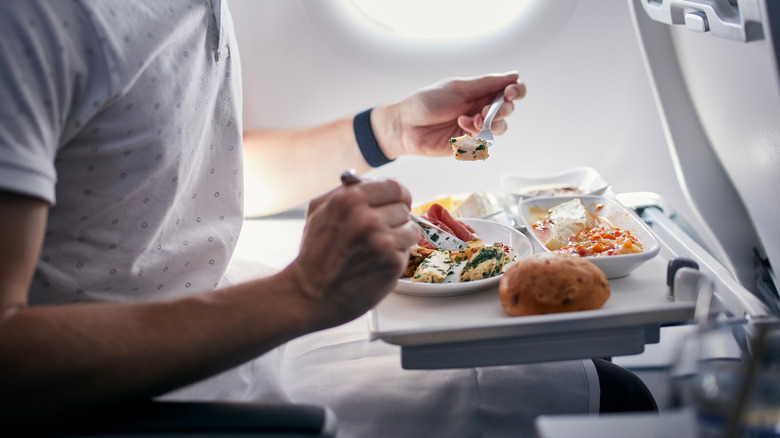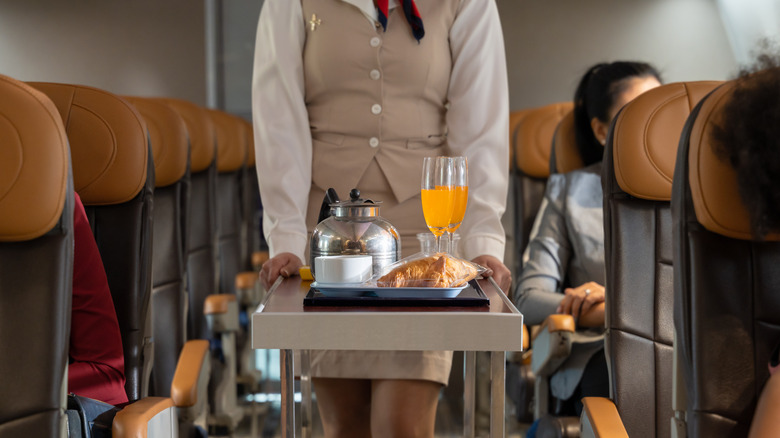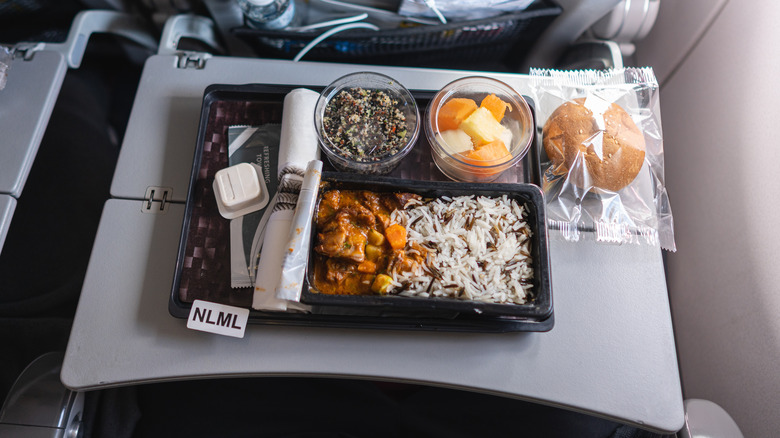The Reason Food Tastes Off When You're On Planes
Airplane food isn't what it used to be. Until 1978, it was standard for airlines to serve a warm, complimentary meal to all passengers. Even on domestic flights and seated in coach, you could get multiple courses of food, complete with appetizers and desserts. Unfortunately, those days are long over, and unless you're on an international flight, you're lucky if you get a bag of pretzels that isn't half-filled with air.
To make matters worse, the food on planes always tastes slightly off. Perhaps you've chalked it up to the fact that the quality just isn't what it used to be, but the truth is that even though passengers used to have more options, the food still had the same flavor issues. According to the BBC, due to the lack of humidity and lower air pressure, it's impossible for the odor receptors in our noses to function properly. Given that 80% of what you taste is influenced by what you smell, the food you eat on a plane usually tastes somewhat different from what you're used to. The taste receptors for sour, bitter, and spicy remain unaffected, but anything that would normally taste sweet or salty will taste bland, ultimately throwing off the balance of a dish.
Food served on an airplane is made differently
To offset these effects, airline caterers use modified recipes. Airplane mac and cheese, for example, isn't the same as the kind you'd make at home. Most airlines add about 30% more salt and sugar to ensure it tastes somewhat similar to how it does on the ground, according to Time. American Airlines, however, takes a different approach, according to Raphael Girardoni, American Airlines managing director of food and beverages. Girardoni told Vox in 2020, "We don't try to add salt since it dehydrates people, but instead add more flavor profiles into our meals."
Though airplane food is cooked on land in commercial kitchens, the actual taste testing is done inside a plane. This entire process happens about 10 hours before it is actually served to you. Once they are cooked, the meals are flash-frozen and then delivered to each flight, where the flight attendants will reheat them in the plane's special ovens.
Why it might be a good idea to avoid airplane food
No one likes bland or over-salted food, but that's not the main reason you may want to avoid consuming the food served on a plane. Whereas packaged snacks and canned drinks are generally safe to eat, CNBC reports airplane meals have a history of causing foodborne illness.
Chicken-based meals are only cooked 60% of the way before they're loaded on the aircraft; steak-based meals are only 30% cooked, according to Thrillist. This allows the meat to finish cooking when a flight attendant reheats it, but there are two problems with this system. Due to the high volume of meals, flight attendants don't check whether each meal is fully cooked. These meals are also not always kept at food-safe temperatures, creating a breeding ground for bacteria, especially if the meat is partially raw.
Certain drinks can also be risky to consume, particularly those that contain hot water. The water tanks aren't always cleaned, which means you could be ingesting dirty water. This, of course, isn't always the case, but if you want to avoid the risk altogether, it's best to stick to beverages and food items that are completely sealed. Considering your meal is going to be heavy on salt and sugar and still taste a bit off, you're probably not missing out on much anyway.


